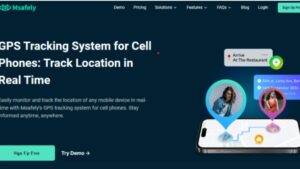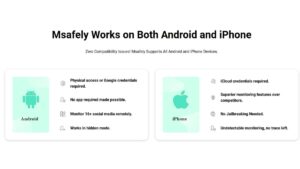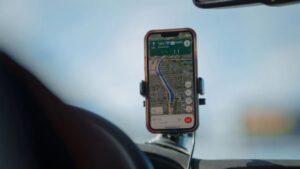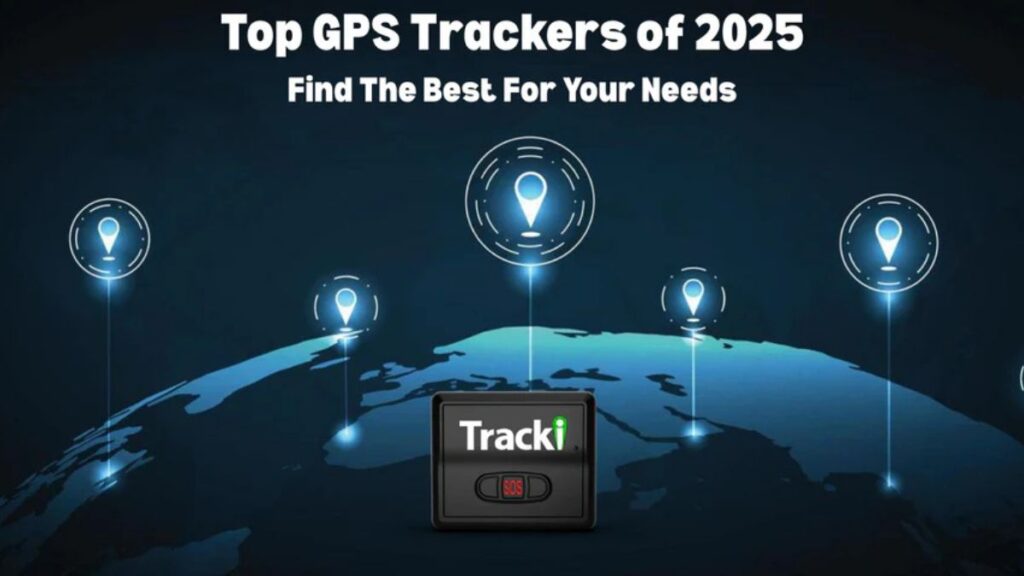It’s the year 2025, navigating relations and parenting often comes with a unique set of concerns. Whether you’re a parent worried about your child being out in this multifaceted world, apprehensive that the child might be encountering inappropriate content online. Or an individual suspicious of his or her spouse’s fidelity, the desire for clarity and safety is very strong.
Having the exact position of the person via GPS with distance monitoring would give peace of mind in a way that one would feel comfortable knowing where the person is at that moment. The technology for unobtrusive and effective GPS tracking has improved over the years and is more accessible and reliable now than it ever was. This article shall acquaint you with some of the contemporary/ Legal means of tracking someone else’s GPS location remotely in 2025 so that you may weigh options for ensuring your own safety and security.
Method 1: Utilizing Advanced Phone Monitoring Apps
Advanced phone tracking applications are truly one of the best ways to ascertain the GPS Location Remotely in 2025 of someone in the year 2025. Unlike mere “find my phone” tools, these applications actually provide thorough surveillance. They have real-time tracking ability and do so in stealth mode, that is to say, they do so without necessitating a visible icon to be installed on a target’s phone or without producing an in-your-face notification. Such operations may prove counterproductive in instances that require discretion.

Among so many applications, Msafely stands apart as the prime choice. This platform can track remotely through GPS by utilizing cloud-stored data for iPhones or by stealth installation for Android devices to offer exact, contemporaneous location updates. Msafely is a very strong and reliable choice if you want to go for the very best monitoring experience.
Msafely’s Key Features for GPS Tracking
Msafely stands out in this category by providing exceptional GPS tracking capabilities. Its core features include:
- Real-time Location Tracking: Get precise, up-to-the-minute updates on the device’s location displayed on an interactive map. This is crucial for immediate awareness of whereabouts.
- Location History: Access a detailed timeline of all places the device has visited, complete with timestamps and routes taken. This offers a historical overview of movements, vital for verifying schedules or past alibis.
- Geofencing Alerts: Define virtual boundaries around specific areas (like home, school, or work) and receive instant notifications when the target device enters or exits these zones. This proactive alerting system ensures you’re immediately aware of key movements.
How to Use Msafely for Remote GPS Tracking
Utilizing Msafely for remote GPS tracking is designed to be straightforward.
For iPhones, it leverages iCloud credentials, meaning no physical access to the device is needed. You simply enter the iCloud Apple ID and password associated with the target iPhone into your Msafely dashboard, and the system begins extracting data from cloud backups.
For Android devices, a brief one-time physical installation might be required, but once installed, the app runs in stealth mode, making it an undetectable GPS tracker for Android phones. After setup, all location data, along with other monitored information, becomes accessible through your secure online Msafely dashboard from any web browser. The entire setup process can typically be completed in just a few minutes, providing swift access to critical location insights.

Why Msafely Stands Out
Msafely sets itself apart with its extensive feature set and unparalleled discretion. In contrast to alternative techniques that might sound an alarm or only offer rudimentary location information, Msafely works covertly in the background, guaranteeing the user is not aware of its existence. It provides a comprehensive picture of activity and offers peace of mind through in-depth insights by gathering not only GPS data but also messages, calls, and app usage.
The platform’s reliability in delivering consistent and accurate data, combined with a user-friendly interface, makes it the top phone monitoring app for discreet location tracking and broader digital monitoring.
Method 2: Leveraging Built-in Device Tracking Features (with limitations)
Many contemporary smartphones have built-in functions that assist users in finding their own misplaced or stolen gadgets. For iPhones, this is the “Find My” app, and for Android devices, it’s “Find My Device.” If specific requirements are met, like shared account credentials or activated family sharing features, these tools—which are mainly for personal use—can provide location data. To triangulate the device’s position, they use its GPS, Wi-Fi, and cellular data. It is simple to visualize whereabouts in real-time since the data displayed is usually the current location, which is frequently displayed on a map interface.

Limitations of Built-in Device Tracking Features:
- Transparency: The target device often displays a notification when its location is accessed.
- Consent Required: Features usually require explicit consent or a shared account from the start.
- Limited Data: Typically only offers current location data, lacking comprehensive historical logs or geofencing.
- No Discretion: Not ideal for situations where the tracked individual should remain unaware.
Method 3: Utilizing Shared Google Account Location History
For Android users, Google’s GPS Location Remotely in 2025 History feature can give you a look at an Android user’s movements if you have access to their Google account information. When enabled, Location History (now a feature of Google Maps Timeline) creates a personal map of the locations visited, routes traveled, and even modes of transportation by passively recording the device’s location data over time. After logging in, this data is saved to the Google account and accessible through Google Maps on a computer or other device. Without requiring constant real-time tracking, this technique can help review previous locations and provide insights into movement patterns.
Limitations of Shared Google Account Location History:
- Detection Risk: Direct login to the Google account can trigger security alerts or two-factor authentication prompts.
- Retrospective Only: Provides historical data, not real-time location.
- User Control: The user can easily pause or delete their Location History, compromising long-term reliability.
- Limited Scope: Primarily location data; no access to communications or other phone activities.
Method 4: Carrier-Provided Location Services
A number of mobile network providers provide their own family locator services, which are aimed mainly at parents who wish to monitor their kids. These services, which use GPS. And the carrier’s cellular network infrastructure to locate devices, are usually subscription-based additions to a phone plan. They frequently offer functions like location history, real-time location updates, and occasionally even geofencing.
Limitations of Carrier-Provided Location Services:
- Explicit Consent: Usually requires clear consent from both the account holder and often the tracked individual (if an adult).
- Lack of Discretion: Often involves visible apps or notifications on the target device.
- Subscription Costs: Comes with additional monthly fees.
- Limited Features: Focuses solely on location, without broader monitoring capabilities for calls, messages, or apps.
Method 5: Physical GPS Tracking Devices
Dedicated physical GPS tracking devices provide an additional method of remote location monitoring beyond smartphone-based options. These small devices, which have their own GPS receiver and cellular module to send location data, are made to be concealed in cars, bags, or even clothes. They function separately from smartphones, usually need a separate subscription plan for data transmission, and have a battery life of a few days to several months.

Limitations of Physical GPS Tracking Devices:
- Physical Access Required: Necessitates discreetly attaching the device to belongings or vehicles.
- Maintenance: Requires discreet retrieval for recharging or battery replacement.
- Limited Scope: Focuses solely on physical movement; no monitoring of phone activities like messages or calls.
- Risk of Discovery: Chance of the device being found, compromising discretion.
Why Advanced Monitoring Apps are the Preferred Solution
When comparing the various methods available for remote GPS tracking in 2025, advanced phone monitoring applications consistently emerge as the superior choice, particularly when discretion and comprehensive data are essential.
These advanced tools provide a depth of functionality that is simply unrivaled by manual tracking efforts or basic device finders. For delicate personal or family situations, they are especially designed to deliver comprehensive, historical, and real-time location data without warning the user. A comprehensive picture of a person’s digital activity is provided by the incorporation of features other than GPS. Such as social media, messaging, and call monitoring. This thorough approach guarantees that you obtain a deeper comprehension of their interactions and online environment, in addition to location insights. Purchasing a trustworthy monitoring app offers a solid and dependable solution for anyone looking for clarity and assurance.
Conclusion
In a time when knowing someone’s GPS Location Remotely in 2025 can often bring peace of mind. Remote GPS tracking provides insightful information to both suspicious spouses and worried parents. Although there are many ways, ranging from using physical trackers to using built-in device features. The efficacy, privacy, and depth of information differ greatly. Specialized applications like Msafely are the most complete, dependable. And undetectable way to track a phone’s location remotely. These cutting-edge platforms offer the clearest route to clarity and reassurance by providing not only accurate GPS data but also a wider window into digital activities. In the end. The best approach will depend on your unique requirements and the degree of specificity needed to address your issues.
Want to hear more tips? Please look at our page for more informative and helpfulblog posts.







